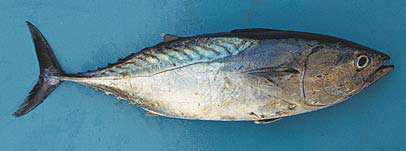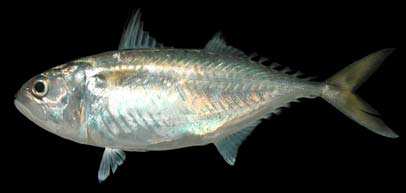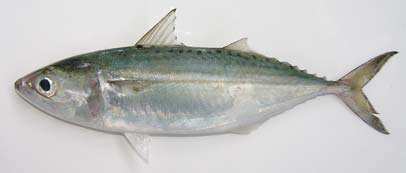SCOMBRIDAE
Mackerels and Tunas
By Seishi Kimura
 Euthynnus affinis |
 Grammatorcynos bilineatus |
 Rastrelliger brachysoma |
 Rastrelliger kanagurta |
 Scomberomorus commerson |
|
Medium to large sized marine fishes, maximum size over 5 m. Body relatively elongate and fusiform, mode r a t e ly compr e s s ed. Snout pointed, upper jaw not protrusible. Caudal peduncle slender with 2 or more lateral keels on each side. Two dorsal fins, the first usually short based with IX-XXVII spines, separated from or apparently contiguous to the second. Finlets (5-12 each) present behind second dorsal and anal fins. Caudal fin deeply forked. Pectoral fins inserted high on body. Pelvic fins relatively small with I spine and 5 soft rays, located below pectoral fins. Body covered with small to medium cycloid scales or a corselet developed on area behind head and pectoral fins. Lateral line present. Color: body dark blue or dark green dorsally, silvery white ventrally. Usually dark vertical or longitudinal bands and/or spots on sides. Similar families occurring in the area. Scombridae is distinguished from other Indo-Pacific perciform fishes in having lateral line on body, pelvic fins below pectoral fins, and unprotrusible upper jaw. Carangidae: dorsal-fin spines III-VIII; II detached anal-fin spines; scutes developed along posterior part of lateral line in most species. Gempylidae: body da rk brown to brown dor s a l l y without distinct marks or blotches; no keels on caudal peduncle except Lepidocybium. Remarks. Typical pelagic fishes; smaller fishes usually inhabits inshore waters; large tunas, Thunnus, transoceanic migrants. Important food fishes. |

|
|